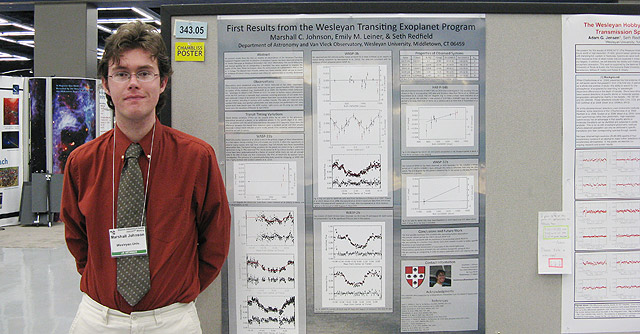Johnson ’11 Honored for Exoplanet Research

Marshall Johnson’s research is out of this world.
For the past two years, the senior astronomy major used the Van Vleck Observatory’s 24-inch Perkin Telescope to study the transits of “exoplanets,” or planets outside our solar system, that orbit another star.
His study, titled “First Results from the Wesleyan Transiting Exoplanet Program,” explains a refined orbital period of a newly-discovered planet named WASP-33b (Wide Angle Search for Planets). Ultimately, Johnson may prove that he’s discovered another planet, WASP-33c.
“Here in Connecticut, with clouds and haze, we don’t have the best observing conditions, but I was still able to obtain high-quality data using our modest-sized telescope,” Johnson says. “The most interesting result, which is still tentative, is that I am seeing transit timing variations in one target. This could be due to an additional planet in the system.”
For his efforts, the American Astronomical Society (AAS) awarded Johnson a Chambliss Astronomy Achievement Award, which “recognizes exemplary research by undergraduate and graduate students.” Awardees are honored with a Chambliss medal and a certificate. He received the medal and certificate during the AAS’s annual meeting and poster session Jan. 10-13 in Seattle, Wash.
Seth Redfield, assistant professor of astronomy, initiated the Wesleyan Transiting Exoplanet Program in 2008. Redfield and Emily Leiner ’10 co-authored the prize-winning poster.
“We in the Astronomy Department are very proud of Marshall’s accomplishment,” Redfield says. “He is an expert observer, and made great progress improving the quality of the exoplanet light curves. He’s also an excellent mentor to the younger students.”
Johnson joined Redfield’s research group in January 2009, focusing his studies on the data reduction of exoplanet transits. Transits occur when an exoplanet passes between its home star and Earth, blocking about 1 percent of the starlight. Johnson uses observations of transits primarily to search for transit timing variations.
A variation could be caused by the presence of the second planet in the system, Johnson explains. The gravity of a second planet in the system would pull the known planet back and forth slightly in its orbit, thus changing the times at which the transits occur.
Johnson continued his studies at the Massachusetts Institute of Technology’s Haystack Observatory during the summer 2009; and in the fall, he worked with Professor Bill Herbst studying young stars. Johnson soon became a “student director” managing the student observers that use the 24-inch telescope for research observations every clear night.
In 2010, Johnson went abroad to Scotland, and applied for, and received, a $4,500 NASA Connecticut Space Grant Award that he used as a stipend for summer research at Wesleyan. He worked with Redfield on the exoplanet transit observations that would ultimately become the foundation for his senior thesis work.
Johnson, who was one of seven students in the country honored with the Chambliss Award, is currently collaborating with astronomers at several other institutions to obtain additional data on his transit timing research efforts.
Johnson is part of a survey named Wide Angle Search for Planets (WASP). His planet is the 33rd planet discovered and is named “WASP-33b.” WASP is the name of the survey that found it and WASP-33b is their 33rd discovered planet; the lower case “b” means it is the first planetary mass object found to orbit that star. The planet that Marshall may have discovered from transit timing variations of WASP-33b has not been named because it has not been confirmed as a planet; however, the next confirmed planet around this star would be named “WASP-33c”.
“Several astronomers at the AAS meeting were impressed with the quality of observations we could get here at Wesleyan. I can see the infrastructure for an important exoplanet program developing here at Wesleyan, and Marshall has been an important part of effort,” Redfield says.

